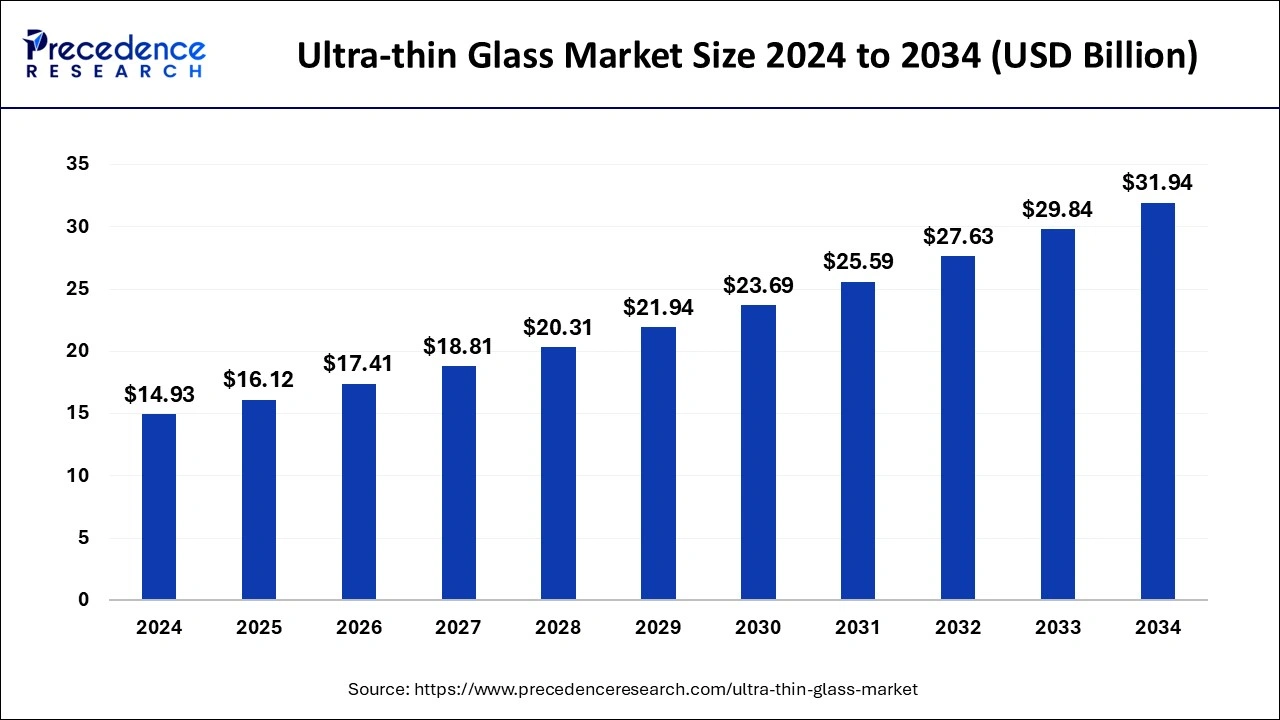The global ultra-thin glass market size was valued at USD 14.93 billion in 2024 and is projected to surpass around USD 31.94 billion by 2034 with a CAGR of 8%.

Get Sample Copy of Report@ https://www.precedenceresearch.com/sample/1149
AI’s Role in Enhancing Ultra-thin Glass Manufacturing
- Automated Production: AI-driven robotics improve precision in glass cutting, shaping, and coating, reducing defects and enhancing efficiency.
- Predictive Maintenance: AI-powered analytics monitor machinery performance, preventing unexpected breakdowns and reducing downtime.
- Quality Control: Machine learning algorithms detect microscopic defects in ultra-thin glass, ensuring consistent product quality.
- Supply Chain Optimization: AI streamlines logistics, optimizes inventory management, and minimizes production delays.
Also Read: https://www.reportsgazette.com/nitrile-gloves-market/
Ultra-Thin Glass Market Growth Factors
Ultra-thin glass possesses exceptional characteristics such as flexibility, transparency, abrasion and corrosion resistance, surface smoothness, and excellent gas barrier properties, making it ideal for use in electronic and optical sensors, touch and display panels, semiconductors, energy storage devices, and organic electronics. The growing adoption of electronic devices, including LEDs, LCDs, OLEDs, smartphones, and laptops, is fueling demand for flat panel displays, which, in turn, drives the growth of the ultra-thin glass market.
Additionally, the increasing production of smartphones, coupled with the rising preference for larger display sizes, is expected to propel the flat panel display segment in the coming years. A notable example is Xiaomi’s launch of the Hongmi Note 5 in South Korea in July 2018, featuring a 0.3mm thick tempered ultra-thin glass, which helped the company expand its market presence in the region.
Beyond smartphones, smartwatches have gained significant traction in healthcare, security, entertainment, and other industries. The growing popularity of wearable technology has led to an increase in production and shipment volumes. For instance, in 2018, Garmin International, Samsung Group, Fitbit Inc., and Apple Inc. shipped 3.2 million, 5.3 million, 5.5 million, and 22.5 million smartwatches, respectively. This surge in smartwatch production is anticipated to further accelerate the demand for ultra-thin glass in the foreseeable future.
Market Scope
| Report Coverage | Details |
| Market Size in 2024 | USD 14.93 Billion |
| Market Size in 2025 | USD 16.12 Billion |
| Market Size by 2034 | USD 31.94 Billion |
| Growth Rate from 2025 to 2034 | CAGR of 8% |
| Largest Market | Asia Pacific |
| Base Year | 2024 |
| Forecast Period | 2025 to 2034 |
| Segments Covered | By Application Type |
Market Dynamics
Market Drivers
The increasing trend of miniaturization in electronics is a primary driver for the ultra-thin glass market. As smartphones, tablets, and other portable devices become slimmer and more compact, the demand for ultra-thin glass continues to rise. The automotive sector also contributes to market expansion, as modern vehicles incorporate more advanced touchscreens and display panels.
Additionally, the rising popularity of high-resolution televisions and gaming monitors has led to increased production of ultra-thin glass for improved screen clarity and durability.
Market Opportunities
The development of ultra-thin glass for 5G communication devices is creating new market opportunities. With the rapid rollout of 5G networks, ultra-thin glass is being explored for use in antenna substrates and signal transmission components.
The biomedical industry is another promising sector, as ultra-thin glass is used in precision optical instruments and diagnostic tools. Additionally, advancements in nanotechnology and coatings are expected to enhance the strength and flexibility of ultra-thin glass, making it more viable for a wider range of applications.
Market Challenges
The delicate nature of ultra-thin glass remains a major challenge, as it is more susceptible to cracking and breakage compared to traditional glass. This necessitates advanced protective solutions and innovative processing techniques to enhance durability.
High initial investment costs in production infrastructure further limit the entry of new market players. Additionally, global supply chain constraints, including disruptions in glass manufacturing and raw material shortages, pose challenges for consistent product availability.
Regional Outlook
Asia-Pacific dominates the ultra-thin glass market due to its strong electronics manufacturing base, with China, Japan, and South Korea being major hubs for display and semiconductor industries. North America is witnessing increasing demand, particularly in aerospace and defense applications where lightweight materials are essential.
Europe remains a key player in the luxury automotive and renewable energy sectors, with growing interest in sustainable production methods. The Middle East and Africa are gradually adopting ultra-thin glass technologies, primarily driven by solar energy investments and infrastructure modernization.
Ready for more? Dive into the full experience on our website@ https://www.precedenceresearch.com/
- Perishable Prepared Food Market Size to Attain USD 157.77 Bn by 2034 - April 24, 2025
- Fabric Filter Market Size to Attain USD 7.50 Billion by 2034 - April 24, 2025
- Pilot Training Market Size to Attain USD 31.38 Bn by 2034 - April 24, 2025
